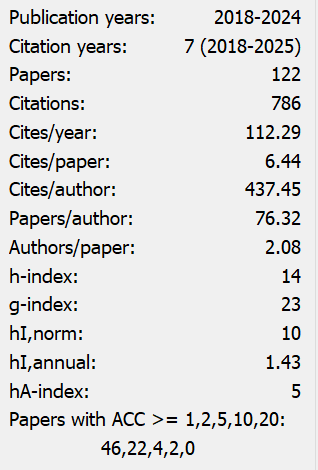The Impact of Foreign Direct Investment on Income Convergence in China - A Spatial Panel Data Analysis
A Spatial Panel Data Analysis
Abstract
After taking into account the spatial dependence effects in the panel data consisting of all 31 provinces, direct-controlled municipalities, and autonomous regions in China between the years 1998 and 2017, it found significant spatial autocorrelation effects in both traditional absolute and conditional β income convergence models. At the national level, using the spatial econometric models (Spatial Error Model for absolute convergence and Spatial Durbin Model for conditional convergence), the analysis shows that in the past 19 years from 1999 to 2017, there is no absolute β income convergence. However, there is conditional β income convergence after controlling for all growth factors, while the positive effect of fixed asset investment on regional economic growth is significant, and the effect of population growth is significantly negative. The other growth factors such as FDI inflow, export, and higher education enrollment were surprisingly found no statistically significant effects on regional economic growth. From regional level (Spatial Durbin Model and Spatial Lag Model), there is no conditional β income convergence within each four economic regions. Nonetheless, the northeast region showed an income divergence trend, where only the fixed asset investment is positively significant. This study results imply that China should continue to improve fixed asset investment and control population growth to stimulate regional economic growth and income convergence.
References
Barro, R. J., & Sala-i-Martin, X. (1992). Convergence. Journal of Political Economy, 100(2), 223-251. https://doi.org/10.1086/261816
Baumol, W. J. (1986). Productivity growth, convergence, and welfare: What the long-run data show. The American Economic Review, 76(5), 1072-1085.
Cai, F., Wang, D., & Du, Y. (2002). Regional disparity and economic growth in China: The impact of labor market distortions. China Economic Review, 13(2-3), 197-212. https://doi.org/10.1016/S1043-951X(02)00072-X
Chen, F., & Sun, X. (2013). Analysis on the changes of convergence of regional economic growth in China: 1984-2010. Journal of Cambridge Studies, 8(1), 116. https://doi.org/10.17863/CAM.1467
Chen, J., & Fleisher, B. M. (1996). Regional income inequality and economic growth in China. Journal of Comparative Economics, 22(2), 141-164. https://doi.org/10.1006/jcec.1996.0015
Choi, C. (2004). Foreign direct investment and income convergence. Applied Economics, 36(10), 1045-1049. https://doi.org/10.1080/0003684042000246759
Chow, G. C., & Li, K. W. (2002). China’s economic growth: 1952–2010. Economic Development and Cultural Change, 51(1), 247-256. https://doi.org/10.1086/344158
Ding Z., Zhao X., & Su, Z. (2012). The core driving force of China's economic growth. China Industrial Economics, (9).
Drukker, D. M., Peng, H., Prucha, I. R., & Raciborski, R. (2013). Creating and managing spatial-weighting matrices with the spmat command. The Stata Journal, 13(2), 242-286. https://doi.org/10.1177%2F1536867X1301300202
Du, C., & Cao, Y. (2010). An empirical analysis of China's economic growth mode-Based on panel data of 28 provinces from 1990 to 2007. Economic Science, (2), 29-41.
Elhorst, J. P. (2010). Applied spatial econometrics: Raising the bar. Spatial Economic Analysis, 5(1), 9-28. https://doi.org/10.1080/17421770903541772
Feng, Z. X. (2008). Spatial correlation and regional convergence in per-capita GDP in China: 1978-2003. China Economic Quarterly, 2.
Getis, A. (2007). Reflections on spatial autocorrelation. Regional Science and Urban Economics, 37(4), 491-496. https://doi.org/10.1016/j.regsciurbeco.2007.04.005
Gong, X., & Yin, Z. (2008). Demographic dividend, wealth accumulation and economic growth. Chinese Journal of Population Science, (6), 33-39.
Hu, A., Liu, S., & Ma, Z. (2012). Population aging, population growth and economic growth: Evidence from China' s provincial panel data. Population Research, 36(3), 14-26.
Hu, Z. F., & Khan, M. S. (1997). Why is China growing so fast? Staff Papers, 44(1), 103-131. https://doi.org/10.2307/3867499
Huang J., & Li, K. (2006). Export openness, regional market size and economic growth. Economic Research, (6), 27-38.
Islam, N. (2003). What have we learnt from the convergence debate? Journal of Economic Surveys, 17(3), 309-362. https://doi.org/10.1111/1467-6419.00197
Jian, T., Sachs, J. D., & Warner, A. M. (1996). Trends in regional inequality in China. China Economic Review, 7(1), 1-21. https://doi.org/10.1016/S1043-951X(96)90017-6
Lambert, D. M., Brown, J. P., & Florax, R. J. (2010). A two-step estimator for a spatial lag model of counts: Theory, small sample performance and an application. Regional Science and Urban Economics, 40(4), 241-252. https://doi.org/10.22004/ag.econ.59780
Li, H. (2004). Comparison of regional differences in the relationship between fixed asset investment and economic growth. Productivity Research, (5), 104-105.
Lin, G., Long, Z., & Wu, M. (2005). A spatial analysis of regional economic convergence in China: 1978-2002. China Economic Quarterly, 4, 67-82.
Liu, X., & Wu, Y. (2013). Export specialization, export diversification and regional economic growth: An empirical study from China's provincial panel data. Management World, (8), 30-40.
Lu, M., Chen, Z., Wang, Y., Zhang, Y., Zhang, Y., & Luo, C. (2013). China's economic development: Institutions, growth and imbalances. Edward Elgar Publishing. https://doi.org/10.1111/apel.12067
Ma, J., & Jia, H. (2015). The role of foreign direct investment on income convergence in China after early 1990s from a spatial econometric perspective. Review of Development Economics, 19(4), 829-842. https://doi.org/10.1111/rode.12187
Malesky, E., & London, J. (2014). The political economy of development in China and Vietnam. Annual Review of Political Science, 17, 395-419. https://doi.org/10.1146/annurev-polisci-041811-150032
Mankiw, N. G., Romer, D., & Weil, D. N. (1992). A contribution to the empirics of economic growth. The Quarterly Journal of Economics, 107(2), 407-437. https://doi.org/10.2307/2118477
Ministry of Education. (1999). Notice of the State Council approving and transmitting the "Action Plan for Educational Rejuvenation Facing the 21st Century" by the Ministry of Education. Retrieved from http://jyt.hunan.gov.cn/jyt/sjyt/xxgk/zcfg/flfg/201702/t20170214_3989965.html
National Bureau of Statistics of China. (2019). National bureau of statistics of China annual data. NBS. Retrieved from http://www.stats.gov.cn/english/Statisticaldata/AnnualData/
National Bureau of Statistics of China. (2021). Main data of the seventh national census. NBS. Retrieved from http://www.stats.gov.cn/tjsj/zxfb/202105/t20210510_1817176.html
National Development and Reform Commission. (2018). Implement the spirit of the 19th national congress of the communist party of China and implement the regional coordinated development strategy. Retrieved from https://www.ndrc.gov.cn/xwdt/gdzt/xxgcxjp19/201804/t20180424_1197861.html?code=&state=123
OECD. (2021). Exchange rates, total, national currency units/US dollar, 1998 – 2017 [Data set]. Organization for Economic Co-operation and Development. https://doi.org/10.1787/037ed317-en
OECD. (n.d.). Fertility rates. Retrieved from https://data.oecd.org/pop/fertility-rates.htm
Pedroni, P., & Yao, J. Y. (2006). Regional income divergence in China. Journal of Asian Economics, 17(2), 294-315. https://doi.org/10.1016/j.asieco.2005.09.005
Qin, Y., & Wang, X. (2017). Higher education scale expansion and China’s economic growth: Evidence from provincial panel data. Macro Quality Research, 5(3), 49-61.
Schultz, T. W. (1961). Investment in human capital. The American Economic Review, 51(1), 1-17.
Solow, R. M. (1956). A contribution to the theory of economic growth. The Quarterly Journal of Economics, 70(1), 65-94. https://doi.org/10.2307/1884513
Song, L. (2011). Re-examination of the relationship between China’s fixed asset investment and economic growth: 1980-2010. Macroeconomic Research, (11), 17-21.
State Council. (2010). Outline of the national medium and long-term education reform and development plan (2010-2020). Retrieved from http://www.gov.cn/jrzg/2010-07/29/content_1667143.htm
State Council. (2014). Central Economic Work Conference held in Beijing. Retrieved from http://www.gov.cn/xinwen/2014-12/11/content_2789754.htm
State Council. (2019). Constantly improving the level of investment in fixed assets continues to play a key role in development. Retrieved from http://www.gov.cn/xinwen/2019-07/29/content_5416197.htm
Tao, R. (2012). The dilemma of China's growth model. https://www.brookings.edu/zh-cn/research/
Tong, M., Liu, H., & Gao, Q. (2014). The impact of China's population policy on economic growth: An empirical analysis based on inter-provincial panel data. Mathematical Practice and Understanding, (15), 175-185.
Wang, J. B. (2009). Thoughts on the export-oriented development model of China's economy. Renmin University of China. Retrieved from http://ier.ruc.edu.cn/asp/09-3/2009-3-f4.pdf
Wei, H. (2002). Effects of foreign direct investment on regional economic growth in China. Economic Research Journal, 4, 19-26.
Wei, K., Yao, S., & Liu, A. (2009). Foreign direct investment and regional inequality in China. Review of Development Economics, 13(4), 778-791. https://doi.org/10.1111/j.1467-9361.2009.00516.x
Wodon, Q., & Yitzhaki, S. (2006). Convergence forward and backward? Economics Letters, 92(1), 47-51. https://doi.org/10.2139/ssrn.875531
Yang, H., & Zhao, D. (2015). Performance legitimacy, state autonomy and China's economic miracle. Journal of Contemporary China, 24(91), 64-82. https://doi.org/10.1080/10670564.2014.918403
Yao, S. (2006). On economic growth, FDI and exports in China. China Economic Quarterly, 7(1), 151-170. https://doi.org/10.1080/00036840500368730
Yao, S., & Wei, K. (2007). Economic growth in the presence of FDI: The perspective of newly industrializing economies. Journal of Comparative Economics, 35(1), 211-234. https://doi.org/10.1080/13504850600905022
Zhao, X. B., & Tong, S. P. (2000). Unequal economic development in China: Spatial disparities and regional policy reconsideration, 1985-1995. Regional Studies, 34(6), 549-561. https://doi.org/10.1080/00343400050085666
Zheng, M., & Zhu, H. (2007). Higher education and regional economic growth: An empirical study based on China's provincial panel data. Educational Research of Tsinghua University, (4), 76-81.
Zhu, Y, & Wang, D. (2010). The contribution of higher education to regional economic growth: An empirical study based on inter-provincial panel data. Soft Science, 24(2), 79-82.
Zhu, Y., Zhou, Z., & Wang, D. (2009). An empirical study on the contribution of higher education to regional economic growth. Statistics and Decision, (2), 88-90.

This work is licensed under a Creative Commons Attribution 4.0 International License.
Copyright for this article is retained by the author(s), with first publication rights granted to the journal.
This is an open-access article distributed under the terms and conditions of the Creative Commons Attribution license (http://creativecommons.org/licenses/by/4.0/).


























